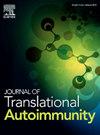Large soluble CD18 complexes with exclusive ICAM-1-binding properties are shed during immune cell migration in inflammation
IF 3.6
Q2 IMMUNOLOGY
引用次数: 0
Abstract
The family of heterodimeric CD11/CD18 integrins facilitate leukocyte adhesion and migration in a wide range of normal physiologic responses, as well as in the pathology of inflammatory diseases. Soluble CD18 (sCD18) is found mainly in complexes with hydrodynamic radii of 5 and 7.2 nm, suggesting a compositional difference. Earlier work reported that the complexes include at least part of the CD11a or CD11b chains containing the intercellular adhesion molecule (ICAM)-1 binding domain, and that sCD18 is capable of quantitatively competing with the cell membrane-bound form for ICAM-1 binding. However, it is not clear if the size differences between the sCD18 complexes reflect any functional variance regarding shedding from the cell membrane or binding to ICAM-1. Here, we show evidence that sCD18 found in serum regulates release of the proinflammatory cytokine monocyte chemoattractant protein-1 (MCP-1/CCL2) from fibroblast-like synovial cells. Further, only large sCD18 complexes are capable of binding to ICAM-1. Migrating neutrophils shed large, but not small, sCD18 complexes. Together, these observations explain results measured from patients with rheumatoid arthritis (RA), where large sCD18 complexes dominated in local inflammatory processes involving neutrophil influx into zones of inflammation. Our data points to a previously unappreciated aspect of sCD18 integrin biology as regulators of inflammation in the context of migrating leukocyte. Surprisingly, this regulation is tied to sCD18 complex size, opening new opportunities for therapeutic intervention in serious inflammatory diseases such as arthritis.
具有特异性icam -1结合特性的大型可溶性CD18复合物在炎症免疫细胞迁移过程中脱落。
异二聚体CD11/CD18整合素家族在广泛的正常生理反应以及炎症性疾病的病理中促进白细胞的粘附和迁移。可溶性CD18 (sCD18)主要存在于水动力半径为5 nm和7.2 nm的配合物中,表明其组成存在差异。早期的研究报道,这些复合物包括至少部分含有细胞间粘附分子(ICAM)-1结合域的CD11a或CD11b链,并且sCD18能够在数量上与细胞膜结合形式竞争ICAM-1结合。然而,尚不清楚sCD18复合物之间的大小差异是否反映了在细胞膜脱落或与ICAM-1结合方面的任何功能差异。在这里,我们展示了血清中发现的sCD18调节促炎细胞因子单核细胞趋化蛋白-1 (MCP-1/CCL2)从成纤维细胞样滑膜细胞释放的证据。此外,只有大的sCD18复合物能够与ICAM-1结合。迁移的中性粒细胞脱落大而不小的sCD18复合物。总之,这些观察结果解释了从类风湿性关节炎(RA)患者中测量的结果,其中大型sCD18复合物在局部炎症过程中占主导地位,涉及中性粒细胞流入炎症区。我们的数据指出了sCD18整合素生物学在迁移白细胞背景下作为炎症调节剂的一个以前未被认识的方面。令人惊讶的是,这种调节与sCD18复合物的大小有关,为关节炎等严重炎症性疾病的治疗干预开辟了新的机会。
本文章由计算机程序翻译,如有差异,请以英文原文为准。
求助全文
约1分钟内获得全文
求助全文
来源期刊

Journal of Translational Autoimmunity
Medicine-Immunology and Allergy
CiteScore
7.80
自引率
2.60%
发文量
33
审稿时长
55 days
 求助内容:
求助内容: 应助结果提醒方式:
应助结果提醒方式:


